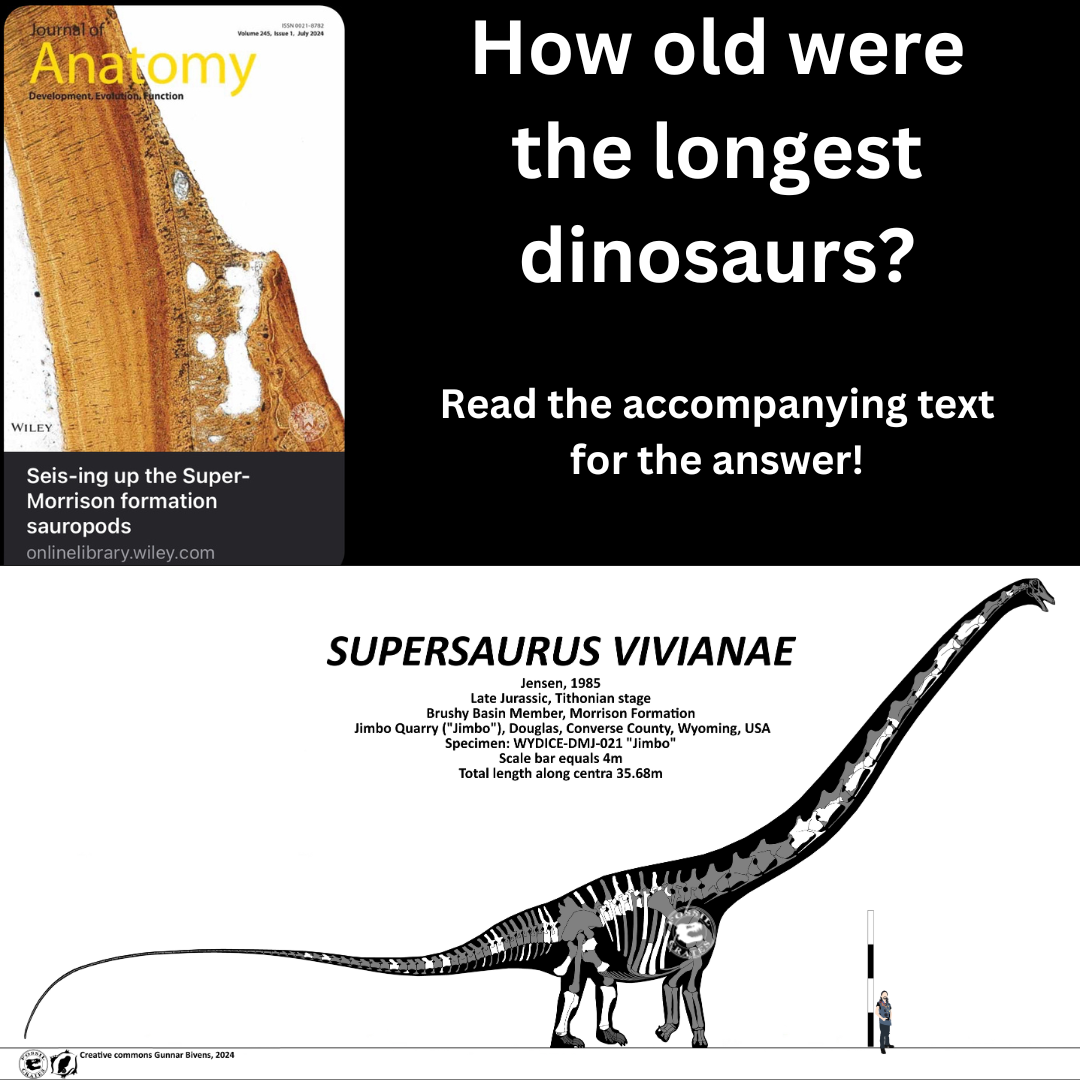
Seis-ing up the Super-Morrison Formation sauropods
Share
Seis-ing up the Super-Morrison Formation sauropods
Drs. Cary Woodruff, Brian Curtice, John Foster
The Morrison Formation has long been a treasure trove of colossal Jurassic sauropod dinosaurs. Among the giants, Diplodocus (=Seismosaurus) hallorum and Supersaurus vivianae stand out not only for their sheer size but also for their skeletal maturity, offering a unique glimpse into the lives of these prehistoric behemoths.
Skeletal Maturity and Age Determination
Through osteohistological analysis, we determined that both Diplodocus hallorum (NMMNH P-25079) and Supersaurus vivianae (WDC DMJ-021) were skeletally mature at their time of death. This conclusion stems from examining long bones and dorsal rib cross-sections, revealing mature osseous tissues. However, a fully remodeled cortex, as seen in some Apatosaurus specimens (e.g., OMNH 01991), was absent, indicating that at least D. hallorum did not live significantly long beyond skeletal maturity.
Retrocalculation of Age-at-Death
The traditional method of counting cyclical growth marks to estimate age is hindered by bone remodeling in these specimens. Instead, retrocalculation methods provide a window into their age-at-death. For Diplodocus hallorum, retrocalculation estimates a maximum age-at-death of around 60 years. This age surpasses the previous records, a 40-year-old Camarasaurus sauropod and the 50-year-old carcharodontosaurid theropod Meraxes.
Estimating the age-at-death for Supersaurus vivianae proved more challenging. The extensive remodeling of its cortex suggests an indeterminable but undoubtedly long period beyond skeletal maturity. Retrocalculation methods yield a speculative maximum age of 225 years, though this figure should be approached with extreme caution due to the limitations of the methodology. To reiterate, we don't believe it was 225 years old at the time of death; rather, this calculation is indicative of its advanced age and the limitations of the methodology on extremely old individuals. We believe it was older than D. hallorum but cannot determine a specific age.
Rarity and Burial Potential of Large Sauropod
The challenges associated with burying such massive creatures may explain the scarcity of large sauropod fossils, particularly complete skeletons, in the Morrison Formation. The sheer volume of sediment required to bury a mature sauropod fully would have been enormous, reducing the likelihood of complete fossilization. Often, only the first few presacral vertebrae, the pelvis, and the base of the tail are preserved articulated. This is likely due to the massive musculature present on diplodocids.
Insights from Triceratops
The oldest and most mature specimens of Triceratops are not always the largest. Skeletal maturity and body size relationships are not expressly tied together. Thanks to the large number of ceratopsian skulls and the many studies conducted on them, it was discovered that some Triceratops specimens exhibited more developed morphologies than their larger, immature counterparts. Size wasn't an automatic indication of maturity.
Implications for Sauropod Life Histories
The findings from Diplodocus hallorum and Supersaurus vivianae offer valuable insights into sauropod life histories. The extensive remodeling observed in Supersaurus vivianae suggests it lived a long life. It is arguably the oldest known dinosaur ever discovered. Alas, how old is impossible to determine.
With three Supersaurus specimens, each within a few meters of one another, the average adult was likely over 35 meters. This would mean an utterly unique 5 standard deviation individual could perhaps have attained 50 meters in length. To grow to these lengths, even for initially fast-growing sauropods (they had to grow extremely fast to get to a size to survive predation), would likely take decades. "Dippy," the famous Diplodocus carnegii, took 24-34 years to reach 27 meters, while it took D. hallorum 60 years to attain ~33 meters, suggesting growth slowed as the animals aged.

Image of "Jimbo"'s skeleton courtesy of Gunnar Bivens
In the case of Diplodocus hallorum, the osteohistological data indicates a recent attainment of skeletal maturity before death. This suggests that its large body size was within the expected range for the species rather than being an outlier. However, factors such as skeletal plasticity and sexual size dimorphism could have contributed to the large size of this individual.
Conclusion
This study underscores the complexity of estimating the ages and understanding the life histories of sauropods. While both Diplodocus hallorum and Supersaurus vivianae were undeniably large and mature individuals, the exact details of their life span remain elusive. Despite their limitations, the application of retrocalculation methods provides valuable, albeit approximate, age estimations that contribute to our understanding of sauropod biology.
With more specimens and advanced methodologies, future research will continue to shed light on these ancient giants, unraveling the mysteries of their growth, maturity, and the factors influencing their fossilization. These insights not only enhance our knowledge of sauropod evolution but also enrich our appreciation of the dynamic and diverse ecosystems of the past.
Bonus Observations from the Study
The only thing a full-sized sauropod needs fear is lightning, illness, and the twisting of an ankle. :-)
The paper can be found here.
Woodruff, D.C., Curtice, B.D. & Foster, J.R. (2024) Seis-ing up the Super-Morrison formation sauropods. Journal of Anatomy, 00, 1–17. Available from: https://doi.org/10.1111/joa.14108
If you'd like to use the illustrations, please cite the artists appropriately:
Supersaurus life restoration commissioned from Sean Fox for Fossil Crates
Skeletal of Supersaurus commissioned from Gunnar Bivens for Fossil Crates
